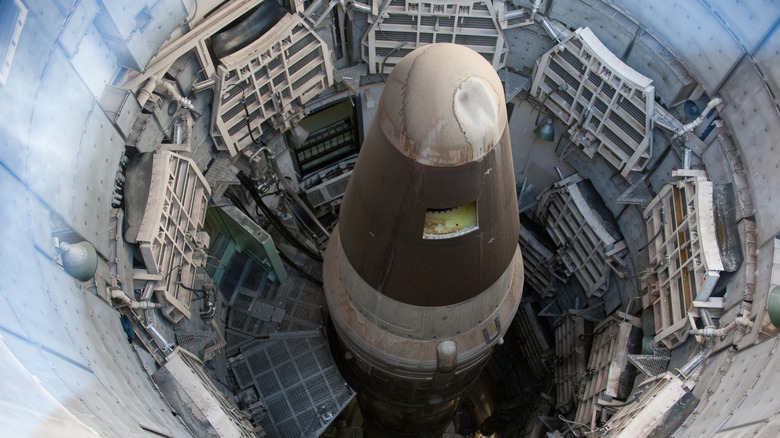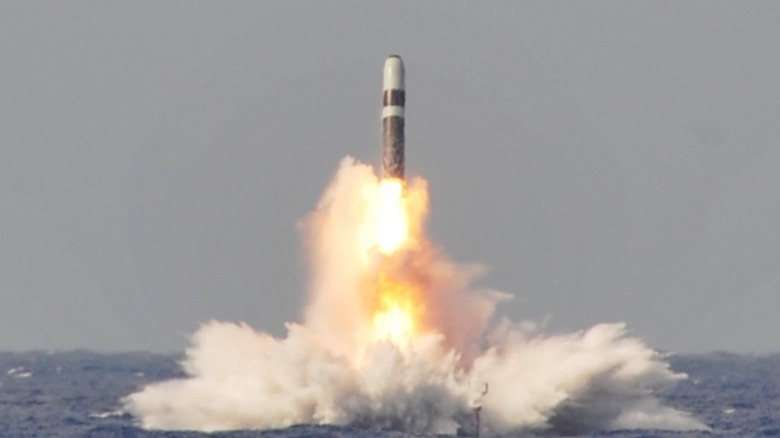Most Of America's Nuclear Warheads Are Stored In This State, And You Probably Never Even Knew It
When it comes to American states trivia, some questions are common. Which one has the most land? (The vast Alaska, of course, at an absurd 665,384 square miles.) The question of which state stores the majority of the country's nuclear warheads, meanwhile, is far more likely to stump most people. The ins and outs of that topic in general, such as the potential difference between atomic and nuclear bombs, aren't well known. Statista reports that, as of January 2024, the United States had a total of 5,044 warheads, behind only Russia (with 5,580) and leagues ahead of the nation with the third most: China, which has "just" 500. It's undoubtedly alarming that so many of these monstrous weapons exist in the first place, but it raises another crucial logistical question about where they're kept. In the U.S., the answer is predominantly New Mexico.
The Kirtland Underground Munitions and Maintenance Storage Complex is located at Kirtland Air Force base to the southeast of Albuquerque. There, the 898th Munitions Squadron presides over what the Albuquerque Journal describes as "unofficially ... the largest storage center for nuclear weapons in the world." This vast facility, then, accounts for the huge stockpile of nuclear missiles in New Mexico. There are about 2,485 warheads held in this secretive facility.
The storage of nuclear weapons in New Mexico
Kirtland Underground Munitions and Maintenance Storage Complex, then, is home to about half of the current U.S. nuclear arsenal. This doesn't mean that New Mexico is equipped to unleash a nuclear barrage, however. With such warheads, the issue isn't simply the sheer number in a given location, but the condition they're in and their intended use. In this case, the Nuclear Notebook Column from the Bulletin of the Atomic Scientists states that "most of the weapons in this location are retired weapons awaiting dismantlement at the Pantex Plant in Texas." Like KUMMSC itself, the Pantex Nuclear Weapons Facility near Amarillo, Texas, is very unique in the United States. It's a 16,000 acre site that the Texas Department of State Health Services declares to be "America's only nuclear weapons assembly and disassembly facility."
It is a highly specialized location that is responsible for crucial duties including development of new nuclear devices and, equally essentially, managing the containment and disassembly of components that contain radioactive materials like plutonium and uranium. Naturally, with these being among the most volatile substances and deadly weapons on Earth, a very limited number of such facilities is properly equipped to store and maintain them (KUMMSC has also been home to warheads like the W88), and so the states that have them will handle a lot of the nation's warheads by dint of that. New Mexico may house more U.S. warheads than any other state, but historically, this hasn't always been the case. Today, they're found in great numbers elsewhere in the country too, not to mention in the arsenals of other nuclear-equipped nations like India and Pakistan.
Washington used to hold the biggest share of the nation's warheads
A 2006 study from the Bulletin of the Atomic Scientists reveals that the picture used to be rather different. Then, Kirtland Air Force Base had a stockpile of approximately 1,914 nuclear weapons, primarily W80-1s and W87s. New Mexico was robbed of the top spot by Washington at the time, with a huge number of Trident I (850) and Trident II (1,100) — the missile pictured above — W76s kept at Bangor. Just behind these two states is Georgia, which has a base for Trident missiles and the submarines — nuclear-powered vessels in more ways than one — that carry them in Kings Bay. In 2006, these numbers stood at approximately 1,364.
There are some important caveats, though. For one thing, these are not all viable nuclear warheads. Of the Kings Bay numbers, for instance, 468 of the warheads, those intended for Trident Is, were inactive. Another important point to bear in mind is that, though the numbers of warheads at the biggest U.S. facilities seem very large, the country has far less warheads than it used to. Amid the enormous lingering threat of the Cold War in the 1960s, the United States accrued as many as 31,255 nuclear weapons. In 2023, it had a little over one-tenth of those numbers.


